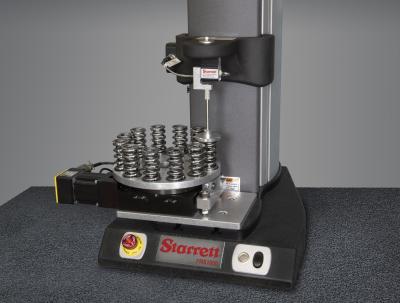
The L.S. Starrett Co. has introduced a newly designed rotary table springs force tester. The system is setup to test multiple springs in a single setup without the need for additional operator input as required when springs are tested one by one. The batch testing volume production approach saves time and significantly increases test throughput, while freeing up the operator to attend to other jobs.
Multiple springs can be loaded and tested in the system, and the system will provide a pass/fail report on each spring. Detailed information on each spring is also available including free length, spring rate, and critical load and distance points. Different rotary table options are available to accommodate a customized number of springs in a single setup.
The rotary table springs tester features the Starrett FMS-1000-L3, a single-column force measurement system optimized for high-volume production and quality control testing. The FMS-1000-L3 frame has a 1,000N (225 lb.-ft.) testing capacity, ideal for tensile or compressive testing.
The system includes the test frame, controller and software. The controller features a Windows operating system with a high-resolution color, multiple-touch display, Wi-Fi, Bluetooth and USB 2.0 port(s). The tester has L2 Plus software that features analysis tools to measure and display results on a single graph. Once this is completed, the results are automatically measured and placed on all of the test runs within a batch. Displays include full graphs, split graphs with data tables, or as a data table complete with statistical calculations or tolerance results.
Contact Details
Related Glossary Terms
- quality assurance ( quality control)
quality assurance ( quality control)
Terms denoting a formal program for monitoring product quality. The denotations are the same, but QC typically connotes a more traditional postmachining inspection system, while QA implies a more comprehensive approach, with emphasis on “total quality,” broad quality principles, statistical process control and other statistical methods.
- tolerance
tolerance
Minimum and maximum amount a workpiece dimension is allowed to vary from a set standard and still be acceptable.
